As consumers and enterprises, we have come to love the convenience brought to us by the internet and Web2 innovations that drive trillions of US dollars in value across the entire internet value chain. All of the internet services we access daily are supported by the internet infrastructure, and made conveniently accessible to users and businesses through cloud infrastructure services: apps and web services are stored on the cloud, our interactions with online content are executed by cloud computing services and the data we request is served to our devices through cloud infrastructure.
The Web2 Cloud Services Market
The cloud is all around us, and it is growing rapidly – Infrastructure-as-a-Service (IaaS), Platform-as-a-Service (PaaS) and Private Cloud revenues have grown consistently since 2015. Synergy Research reports cloud infrastructure services revenues have grown 34% year-on-year in Q1 2022, representing an accelerated growth trend that indicates healthy adoption of internet services globally. Amazon Web Services (AWS), Microsoft Azure and Google Cloud are the largest cloud infrastructure services providers having earned US$191 billion in revenues over the last 12 months. Indicating that the total addressable market (TAM) for Web2 cloud services was around US$294 billion for same period.
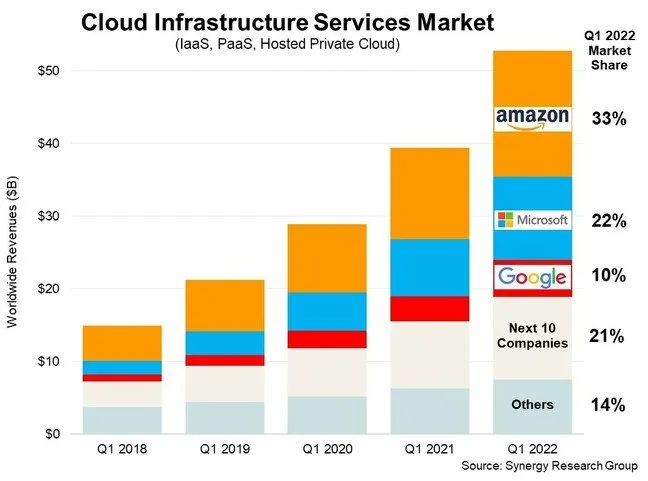
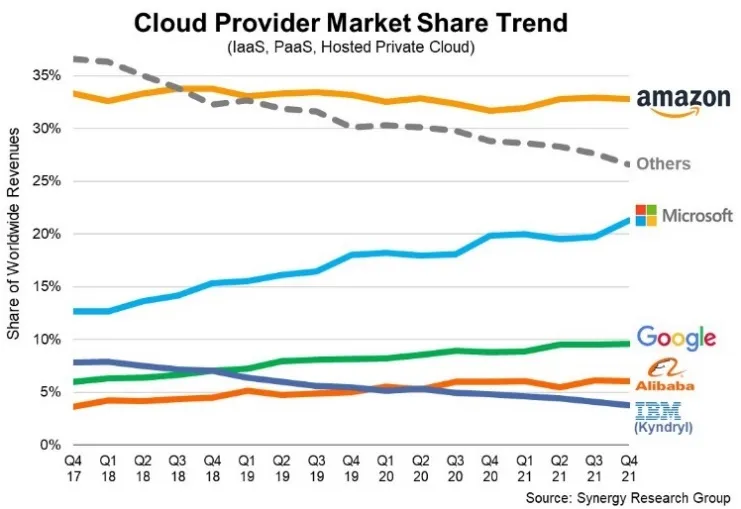
Synergy's cloud market share data for Q1 2022. Sources: Synergy Research (1, 2)
Amazon, Microsoft, and Google accounted for a collective global market share of 65%, a staggering +12%p increase compared to Q1 2021. The increasing proportion of new internet users globally as well as the high proportion of not-yet-connected users indicates that new demand is far from being depleted. Some researchers estimate industry CAGRs at 16.3% into 2026 with the industry expected to grow to US$947 billion – which is a highly conservative estimate considering Amazon, Microsoft, Google and Alibaba (“the Big4”) collectively grew at a CAGR of 31% from the 2018-’21.
Cloud Services to Grow, Consumer Sentiment Shifting Towards Web3 Structures
While the cloud service industry is poised to grow, a large majority of users and enterprises are increasingly wary of these large organizations and the monopolistic dependencies they have created. Their power over the internet value chain reaches so far that access to infrastructure services are allowed only in exchange for user data, and access can be blocked at any time without having to provide a reason.
The above indicates a shift in consumer preference towards infrastructure and applications that provide democratized access and give consumers more choice. Web3, the next iteration of the internet, is the natural progression from current Web2 status quo, redefining the relationships between users and cloud infrastructure service providers. Many Web3 networks exist, with some of the most popular being Ethereum, BNB Chain and Solana.
Web3 Infrastructure Provider Revenue Growth Outpaces Web2 by over 17x
For any infrastructure provider on Web2 and Web3, the total revenue is an indication of the adoption of the underlying infrastructure. If we compare revenue growth of the Web2 Big4 to that of infrastructure providers on the Ethereum Web3 network (referred to as validators or miners), we can see just how strong the consumer interest in Web3 really is. Revenue for Ethereum infrastructure providers grew by a factor of 19x in only three years, outpacing the Big4’s cloud services revenue growth by over 17x, which only grew 1.7x in the same period.
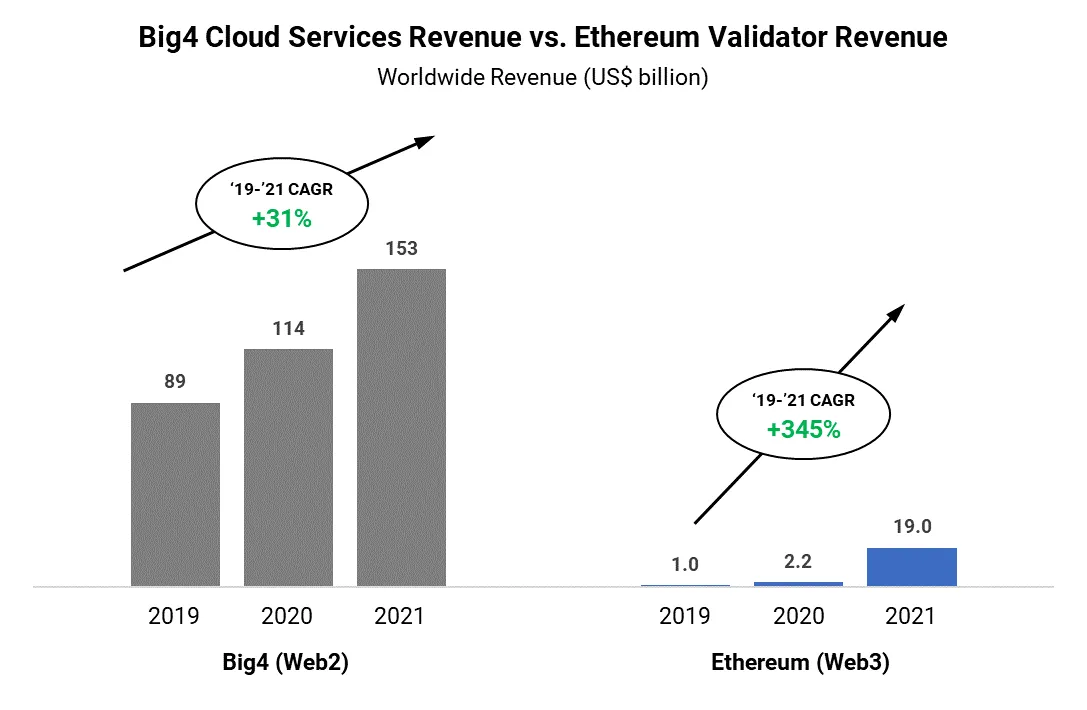
Big4 Cloud Services vs Ethereum Validator Revenue. Source: Statistic.com, Statista.com, The Block
Today, with all the innovations that are currently being built on Web3 and the explosive demand-driven growth, Web3 closely resembles the early internet. Atlas, a one-stop Infrastructure-as-a-Service provider for Web3, entered the industry in 2018 and has grown to become one of the leading infrastructure service providers. Their node infrastructure helps support the vast Web3 ecosystem that exists today.
While the Web3 ecosystem is vast, the industry as a whole is still young with much room for growth. It is only a matter of time for Web3 infrastructure to displace Web2 and re-shuffle the current infrastructural dynamics. Amazon and Google are well-aware of the potential threat that Web3 poses to their existing IaaS service models, and have set up teams to explore opportunities in Web3.
Web3 and Data Ownership
While the Big4 have a strong foothold in traditional Web2 cloud services, Web3 is a whole new arena, where experienced players have a key advantage based on years of specialized experience and deep understanding of decentralized networks.
In Web3, instead of accessing a closed network that is owned and operated by a centralized IaaS provider, users access a public network that is operated by thousands of independent nodes that abide by strict rules defined by the code of the network. Users and enterprises can build and contribute to Web3 apps (decentralized apps), communities (decentralized autonomous organizations), and the infrastructure that powers these (node infrastructure). This means that there is no single entity that can control access to data on the network, and any attempt to do so will be rejected by thousands of nodes on the network.
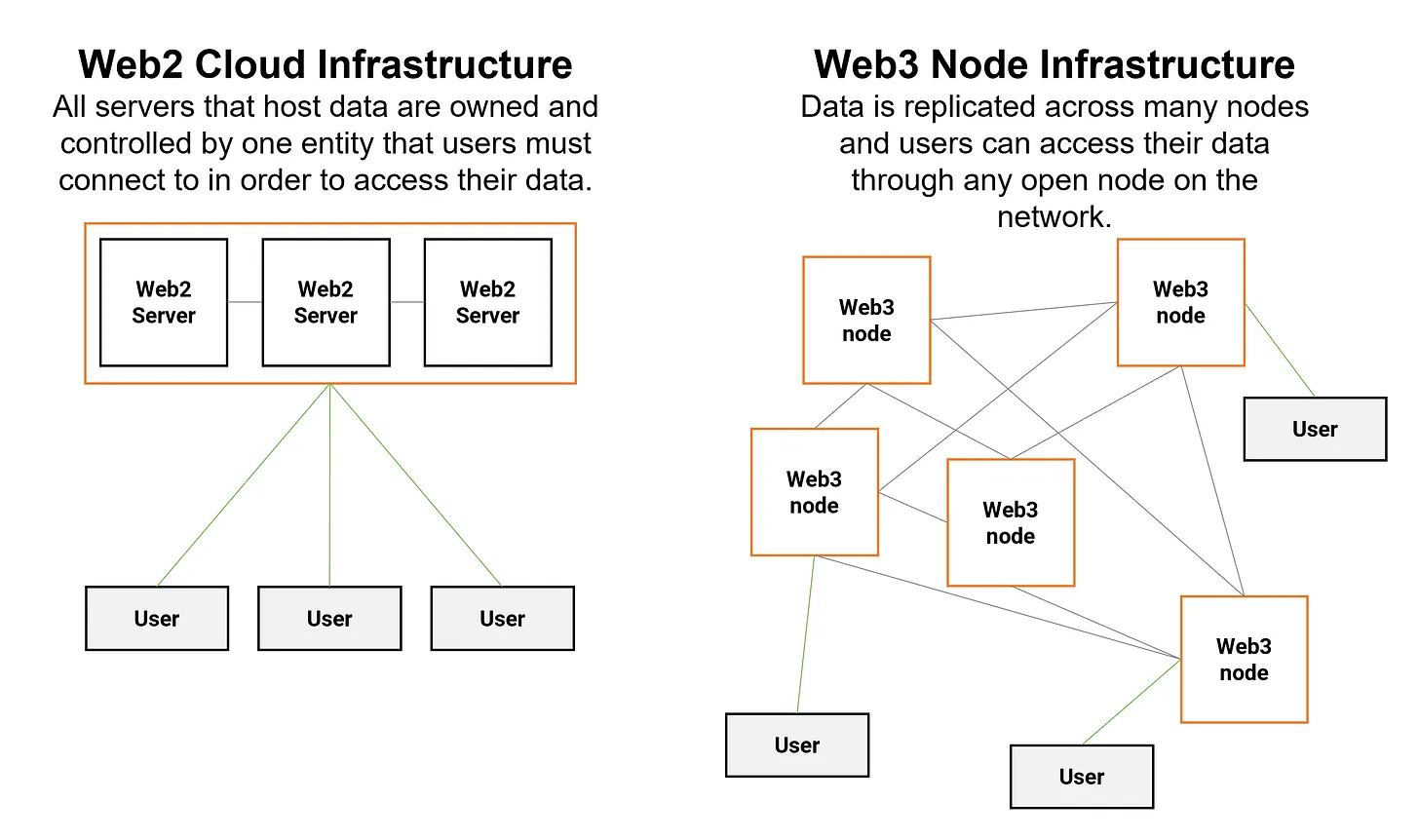
Brief overview of Web2 vs. Web3 infrastructure
In essence, data is stored on a network of independent nodes which all individually ensure that only the data owner can decide what happens with their data. This is in stark contrast to centralized server controlled by a Web2 cloud service provider, who can revoke access to data and even wipe all data of any user without warning. Nodes that contribute to validating data on Web3 networks are called validators or miners.
Why IaaS
While anybody can become a validator on most Web3 networks, becoming a validator is often technically challenging, requires a minimum investment in hardware and network infrastructure, as well as an investment into the network itself. As a result, many people opt to use IaaS providers such as Atlas to avoid these high upfront costs. Web3 IaaS providers remove the complexity around running nodes and participating in validation on Web3 networks. This enables users and enterprises to operate their own nodes without the infrastructural overheads while earning revenue as validators, or to build their own services with a private node that enhances security between off-chain environments and on-chain ecosystems.
Atlas is one of the leading Web3 Infrastructure-as-a-Service providers, providing end-to-end infrastructure services across over 100 protocols. With services such as node hardware and software infrastructure setup and operation, networking, decentralized storage interfaces and Web3 network API support enabling off-chain environment and on-chain ecosystem communication, Atlas covers every aspect of Web3 infrastructure, while driving green energy adoption and driving power usage efficiencies across its entire infrastructure. Apart from the technical aspects, Atlas is also experienced in operating nodes across more than 30 countries, navigating the complex regulations surrounding the Web3 industry.
Web3 Infrastructure Overview
Web3 infrastructure has flourished over the last few years, with the below snapshot of top protocols and companies only showing the tip of the iceberg. We categorize the Web3 infrastructure in multiple sections reflecting the on-chain ecosystem, the off-chain environment that supports the development and growth of the on-chain ecosystems, middleware that connects on-chain ecosystems and the off-chain environment, and finally other services that live across the above sections.
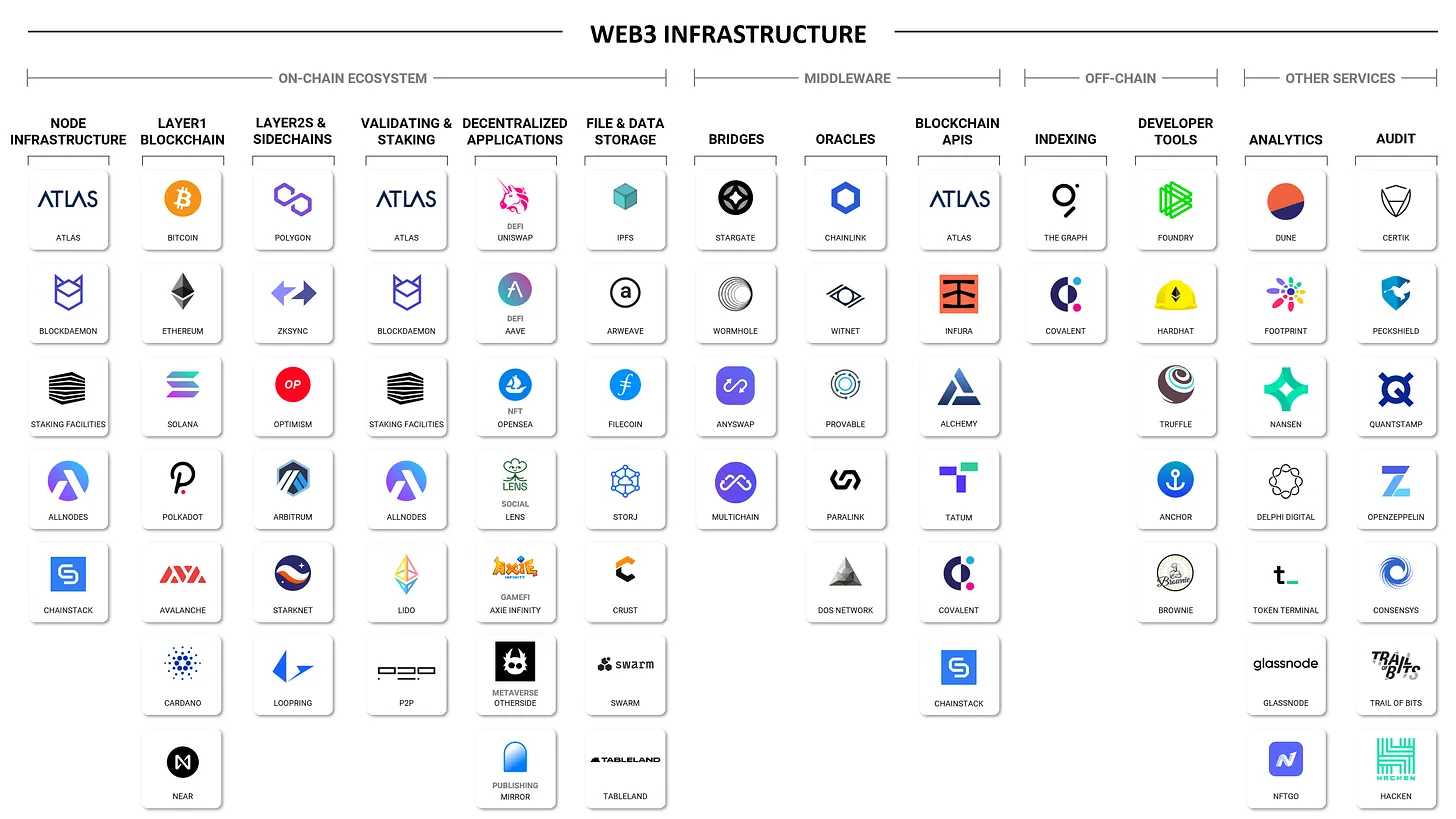
Overview of key players in Web3
The On-Chain Ecosystem
The on-chain ecosystem is the heart and soul of the Web3 infrastructure. This is where IaaS providers such as Atlas provide the node infrastructure as well as contribute to the overall security of blockchain networks through validating and staking operations. What is unique about Atlas is the breadth of services they provide: Atlas is a one-stop IaaS provider with capabilities to provide the entire underlying infrastructure for any Web3 network, as well as provide middleware services through their blockchain APIs.
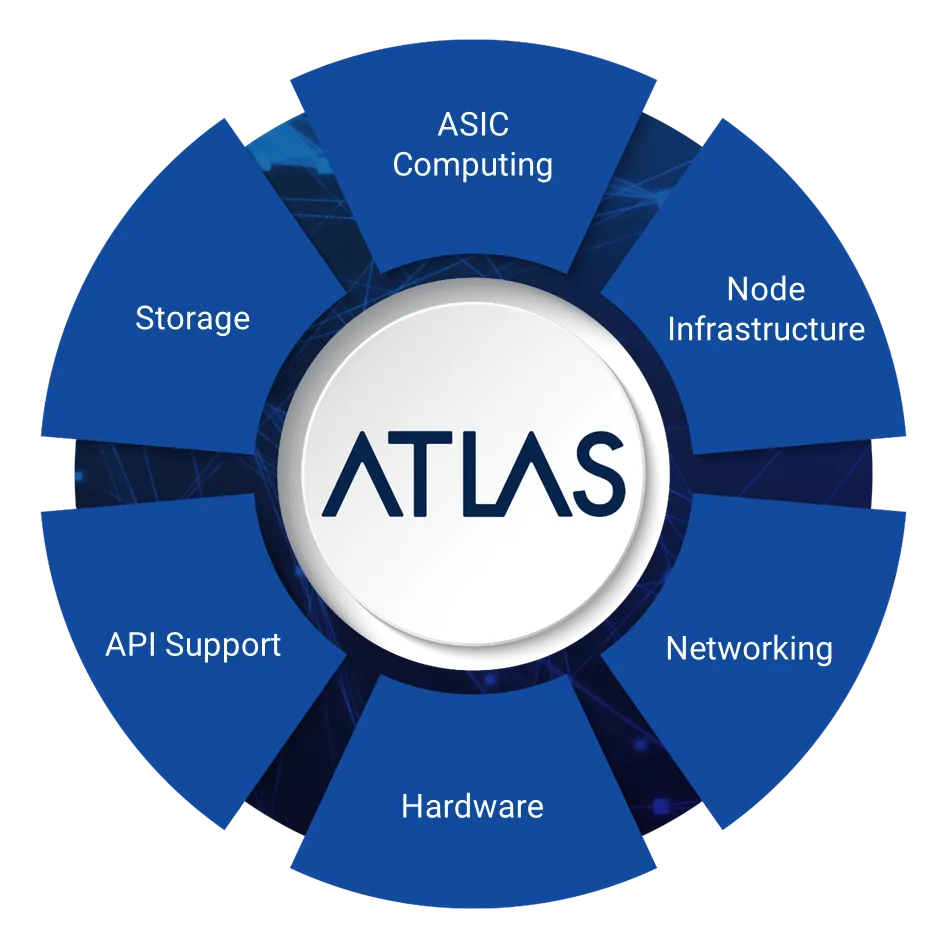
On top of that foundational infrastructure, decentralized applications (dApps) make use of the unique characteristics of blockchains to deliver services to end users. dApps can be split into a handful of categories, including but not limited to DeFi, NFTs, social, GameFi, Metaverse and even publishing. These dApps tap into decentralized file and data storage services to offload storage and computational workloads to reduce network congestion and costs associated with using their services – another service offered by Atlas as part of their one-stop Web3 service suite.
Middleware
Middleware is responsible for communication between Web3 networks, and for connecting the on-chain ecosystem to the off-chain environment. Blockchains are incapable of communicating beyond the nodes in their network, and thus rely on other tools to bridge that communication. Blockchain API services ensure communications between blockchains, and on-chain and off-chain environments are successful and can be executed safely. Nodes are ultimately the gateways to access blockchains, and that access is controlled by blockchain APIs. Bridges and Oracles rely on blockchain APIs for accessing blockchains: Bridges facilitate value transfers between blockchain networks and Oracles enable the transmission of off-chain data to be stored on-chain.
The proximity of middleware solutions to node infrastructure makes this section a natural expansion for one-stop IaaS providers such as Atlas. Blockchain APIs and related gateway services are becoming increasingly more important as the Web3 ecosystem continues to expand.
Off-chain environment
While the off-chain environment includes the entire Web2 ecosystem, from a Web3 perspective indexing and developer tools are of primary importance. Blockchains store huge amounts of transaction data, reflecting actions undertaken on the network through dApps or directly through transfers. This data is stored in bytecode and is not human-readable, unless it is decoded and indexed, i.e., it is made human readable, ordered, and labeled in a way that it can be queried, and the data used for analysis and research. Developer tools help to streamline the coding, testing, and deployment of smart contracts and dApps to various blockchains. They are essential developer tools, without which most dApps today may have never been released due to the increased workload.
Other Services
Analytics and auditing services make up the other services in the blockchain ecosystem. Analytics services use querying solutions and can both provide users with direct access to decoded blockchain raw data or illustrate blockchain data in the form of charts and tables. Ultimately the purpose is to provide users with insights into what is happening on the blockchain. The Web2 equivalent to this would be Bloomberg terminal, with the difference that all transactions on blockchains can be captured and analyzed, giving insights into all sorts of on-chain behavior across all dApp categories.
Finally, auditing firms use both professional security engineers as well as financial accountants to review the smart contract security as well as offline financial compliance of Web3 projects. With the added complexity of Web3, new forms of auditing emerged that seek to ensure that smart contracts, dApps and Web3 companies provide secure services to Web3 users.
Web3 IaaS is the Foundation of the Web3 Future
An entire industry has formed around blockchain technology, which is ushering in the next generation of the internet. We are moving from Web2 to Web3. At the most foundational level, leading infrastructure service providers such as Atlas are ensuring the fundamental building blocks of Web3 are set and that networks are prepared for the growing user base. Adoption of Web3 is accelerating, with revenues growing fast. Despite the industry’s rapid expansion, there is still room for further growth as more and more people across the world receive internet access and Web3 continues to convert Web2 users into Web3 users.
Want to learn more? Visit www.atlasweb3.io and get in touch with Atlas!